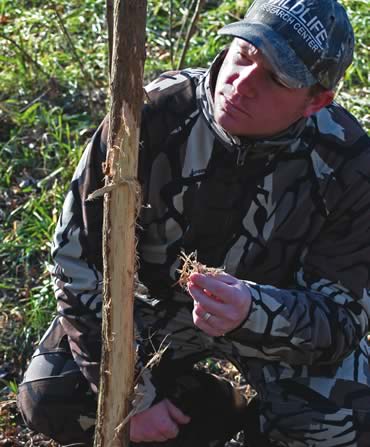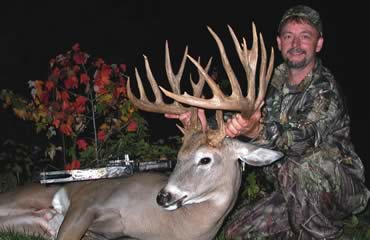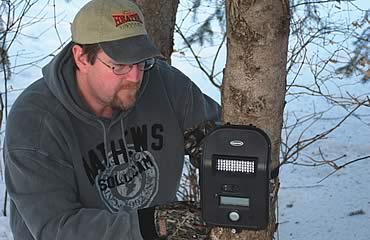Whitetails in large timber tracts are harder to pattern, but it’s not impossible.
As the buck stood on the ridge, nose held high, it inhaled the alluring odor of the estrous scent I had placed well above its reach. It took several steps forward and began to scan the bedding area below for the hot doe. Within seconds, a blast of scent placed closer to my stand caught the buck’s attention. As though on a rope, the mature 12-pointer closed to 42 yards before it stopped to scan again.
With my bow already at full draw, I settled the 40-yard pin behind the deer’s shoulder and sent the arrow on its way. A mule kick and 20 yards later, the buck flipped on its back and expired.
Hunting big woods can be downright intimidating. Some cite the fear of getting lost, but a good map and compass or GPS can take care of that. No, the real intimidation for many hunters is the question of where to start. That’s understandable when so many of us target small woodlots for most of our deer hunting.
 Big Woods Bucks Are Different
Big Woods Bucks Are Different
First, let’s define “big woods.” I define big woods as chunks of timber of at least 400 acres. While the 400-acre minimum might seem small, I base my definition on how bucks use the habitat.
Unlike deer in smaller tracts, big-woods bucks never have to leave their home ranges; all their needs can be met within the habitat’s protective cover. Sure, some deer will venture out of even the biggest stretches of timber, but they don’t have to. Also, they typically have pockets of refuge where they can lay low. In many cases, they can’t even be driven from cover by the most well orchestrated deer drive. Instead, they’ll either hold tight, watching the pushers walk by, or just slip between them by doubling back to return to their private sanctuaries.
Additionally, when they feel pressure, big-woods bucks are more willing to relocate. After all, they have the elbow room to do so. That’s not to say that they’ll abandon their home range. However, their homes tend to be considerably larger than those of small-woodlot bucks.
One of the reasons big-woods bucks move more is because they often must shift their patterns with the changing food sources. Large tracts of land might offer ample hiding places, but they often lack a surplus of prime food.
Find the Food, Find the Bucks
Although there might be miles of habitat, during hunting season, about 80 percent of the deer will be concentrated in less than 20 percent of the habitat. Why? That’s where the best food is at that time of year. Knowing that makes hunting in the big woods a little less intimidating.
Finding the food source is the challenge, however. Deer will eat just about anything to survive, but they have definite preferences for certain foods — usually that offering the most nutrition. And the preferred list varies from region to region. In my home state of Wisconsin, the big-woods deer staples are acorns, weeds, grasses, aspen leaves, assorted woody browses available in clear-cuts, and bait piles.
Travel to the big woods in southern Ohio, and you’ll find some of the same foods, but you’ll also find Japanese honeysuckle, mountain laurel and locust pods.
Go even farther south, and things change again. Persimmons are more common, and old apple orchards dot the landscape. Sure, clear-cuts, acorns, grasses and weeds are still big, but other foods are important, too.
 Bottom line: If you want to hunt the big woods, you have to learn what foods the deer eat and the time of year they eat them. Luckily, it’s not too difficult to figure out. If you already know the prime food sources in your area, you’re well on your way. If not, call a local deer biologist. Most are happy to give you a list of preferred foods and when they’re hot. That is a huge first step.
Bottom line: If you want to hunt the big woods, you have to learn what foods the deer eat and the time of year they eat them. Luckily, it’s not too difficult to figure out. If you already know the prime food sources in your area, you’re well on your way. If not, call a local deer biologist. Most are happy to give you a list of preferred foods and when they’re hot. That is a huge first step.
Once I know the preferred food sources, I try to find one that’s in short supply. Pockets of oaks in aspen- and pine-dominated woods, or the lone oak ridge with trees laden with acorns in a poor mast production year, are good examples. A lone clear-cut can produce similar results, and isolated meadows and pockets of Japanese honeysuckle are worth investigating.
In each case, the key is that the food is in relatively short supply. Because deer crave a diverse diet, the food’s limited availability increases its appeal and concentrated feeding effect. Of course, if an isolated meadow is surrounded by acorn-producing ridges, you know that the deer will be feeding heavily on acorns. But when they get a taste for greens, you just happen to be covering the only major source available.
Do Not Disturb
While doing your scouting, take all the normal precautions you would in scouting a small property. But keep in mind that big-woods bucks can afford to be spooky. If they feel threatened, they will shift patterns in a blink of an eye. While the does often simply go nocturnal, the mature bucks are much more likely to abandon a prime food source where they feel threatened in favor of a marginal one where they feel safe.
Odor control is a critical first step. Deer on small tracts are relatively used to human odor; they fear it, but it’s something they encounter on a regular basis. Big-woods deer are different. With few exceptions, when these deer smell human odor, it’s because someone is trying to kill them. If you weren’t an odor-control freak before, you need to become one to hunt the big woods.
 Strike When It’s Hot
Strike When It’s Hot
The last real key is to strike when it’s hot. With mature bucks shifting their patterns because of changing food sources, the rut and hunting pressure, you often don’t have much time to tag them at any one spot. While that’s true of almost all buck hunting, it’s magnified in the big woods.
A great example of this is northern Wisconsin hunter Larry Kline’s quest for the Ghost Buck. For three seasons, Larry had his heart set on taking that buck or none at all. Despite hunting it hard, Kline hadn’t even seen the big-woods giant once from a stand; his only sightings were from his truck and a trail camera picture.
Checking his camera just before the opener of Wisconsin’s 2004 archery season, Kline was thrilled to see he had a new picture of the gigantic buck. He immediately changed plans to hunt the funnel stand near where the picture was taken. The next morning, his three-year quest ended happily. If he’d waited even one more day, who knows?
The big woods are challenging to hunt. Sprawling cover gives deer the ability to seemingly vanish from the face of the earth. Unlike hunting farm country, where numerous deer sightings are expected, seeing one deer in the big woods can be a challenge. But if it’s the right deer, that’s all that matters. Locate bucks by finding the food. Keep disturbances to a minimum, and jump on stands when the sign is fresh.
Read Recent Articles: • Antler Intrigue: Of the recognized big buck factors, which is really most important?
• The 5 Ws of Decoying Deer: Who, What, When, Where, How and Why to use deer decoys
• Where Do All the Big Bucks Go?: Be prepared to get cut and dirty if you want to go where the giants roam.
This article was published in the November 2008 edition of Buckmasters Whitetail Magazine. Join today to have Buckmasters delivered to your home.